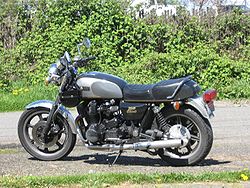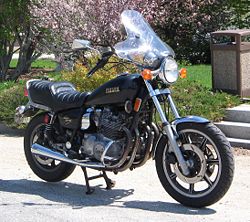
Yamaha XS Eleven
Encyclopedia


Yamaha Motor Company
, is a Japanese motorized vehicle-producing company. Yamaha Motor is part of Yamaha Corporation and its headquarter is located in Iwata, Shizuoka. Along with expanding Yamaha Corporation into the world's biggest piano maker, then Yamaha CEO Genichi Kawakami took Yamaha into the field of motorized...
XS Eleven motorcycle
Motorcycle
A motorcycle is a single-track, two-wheeled motor vehicle. Motorcycles vary considerably depending on the task for which they are designed, such as long distance travel, navigating congested urban traffic, cruising, sport and racing, or off-road conditions.Motorcycles are one of the most...
, also called XS11 and XS1100, is a Japanese
Japan
Japan is an island nation in East Asia. Located in the Pacific Ocean, it lies to the east of the Sea of Japan, China, North Korea, South Korea and Russia, stretching from the Sea of Okhotsk in the north to the East China Sea and Taiwan in the south...
superbike produced from 1978 to 1981, powered by an air-cooled 1101.6cc 4-stroke, DOHC inline four-cylinder
Straight-4
The inline-four engine or straight-four engine is an internal combustion engine with all four cylinders mounted in a straight line, or plane along the crankcase. The single bank of cylinders may be oriented in either a vertical or an inclined plane with all the pistons driving a common crankshaft....
engine
Engine
An engine or motor is a machine designed to convert energy into useful mechanical motion. Heat engines, including internal combustion engines and external combustion engines burn a fuel to create heat which is then used to create motion...
mounted transversely in a duplex cradle frame with swingarm
Swingarm
A swingarm, or "swinging arm" is the main component of the rear suspension of most modern motorcycles and ATVs...
rear suspension, shaft drive
Driveshaft
A drive shaft, driveshaft, driving shaft, propeller shaft, or Cardan shaft is a mechanical component for transmitting torque and rotation, usually used to connect other components of a drive train that cannot be connected directly because of distance or the need to allow for relative movement...
, and telescopic forks.
Models
The XS Eleven made its debut in 1978 as the largest capacity Japanese superbike then currently in production. It featured dual front disc brakes, a rear disc brake, shaft drive and cast wheels. A "factory custom" styled XS Eleven Special was released alongside it in 1979. Both models were superseded by the 1982 XJ1100 Maxim which used an engine based very closely on the XS1100 unit. The XJ1100 Maxim was only built for one year, before being phased out. In Europe, the XS Eleven differed from the North American model by having a larger gas tank (6.3 US gallons vs. 5.3 US gallons), a lower handlebar and longer exhaust pipes. The European market also featured the 1.1 Sport (based on the Special model) and Martini (based on the original XS1100) versions. Both of these additional models were faired.History
The XS Eleven was the first four-cylinder four-stroke motorcycle from Yamaha. It exploited well-proven technology, first used by Yamaha in their previously released XS 750 four-stroke triple. When the XS Eleven was introduced, it earned a reputation as a heavy, powerful bike. At the time of its release it was the most powerful production motorcycle money could buy. "Nobody gets far riding the XS11 before they become acquainted with the fact that it's strong; we had ridden ours over hundreds of open-road miles before going to the drag strip and knew it was a bullet." The handling of the XS Eleven was not as well received. "When this behemoth of a motorcycle actually hits a corner at anything approaching interesting speeds then it takes a good deal of muscle to lay it down. While the Yamaha doesn't disgrace itself in corners (not as much as some Z1000s I have known, for example) it doesn't commend itself either."In 1979, Yamaha followed the growing trend of offering a "factory custom" version of the bike, called a "Special" by Yamaha. Pullback handlebars, a stepped seat, a smaller, fatter rear wheel, a smaller capacity tear-drop gas tank, fully adjustable suspension, and altered frame created a factory custom, forerunner of the modern cruiser. The XS Eleven Special sold well despite complaints about the poor ergonomics
Ergonomics
Ergonomics is the study of designing equipment and devices that fit the human body, its movements, and its cognitive abilities.The International Ergonomics Association defines ergonomics as follows:...
. "What that translates to is a bike with an awkward riding position but generally excellent road manners. In fact, most of the things that irritated this staff in the way the bike rode and handled could be traced to the handlebar, which, although certainly as trendy as disco dancing, was not what the ergonomics doctor ordered for precise, comfortable control."
British motorcycle journalist Roland Brown, in his book Superbikes of the Seventies, says "The Yamaha's lack of reputation gives it one advantage these days, though, in that a clean XS such as this one costs less than its more successful contemporary rivals - whose performance advantage, so crucial then, is far less important now. Two decades and more after its launch, maybe the XS1100's time has finally come."

